Our Blog - Carcassonne
This weekend we decided to do a quick road-trip to Carcassonne which is about 50 miles east of Toulouse. This is another reason that we wanted to move to France ... where in the US can you find a town where the first settlement in the area was 3500 BC, and became a Roman city on a hilltop around 100 BC??
This hilltop city (the citadel or medieval city) was in a great location for trading and became an important trading center in the 6th century BC, leading to the Roman fortification of the city. It remained Roman until 462, when it was ceded to the Visigoths. As with many towns, the early years were quite tumultuous ... while the Visigoths were able to foil attacks in 508 from the Frankish king Clovis; they lost to Saracens from Barcelona in 725, and were retaken by King Pepin the Short in 760 (although not the fortress itself).
In 1067, Carcassonne became the property of Raimond-Bernard Trencavel, viscount of Albi and Nîmes, through his marriage with Ermengard, sister of the last count of Carcassonne. To keep control, they allied with the counts of Barcelona and Toulouse. They were quite worried about invasion (and rightly so) and built the Château Comtal as a fortress inside a fortress. With the Albigensian Crusades, the city was a stronghold of the Cathars who eventually lost, and the city surrendered in 1209 and by 1247, was back under French rule. The city lost importance and the fortified city fell into such disrepair that the French government decided that it should be demolished in 1849. However, it caused such an uproar that it wasn't demolished and the the fortress was preserved (and rebuilt) as a historical monument.
Trivia: Portions of the 1991 film Robin Hood: Prince of Thieves were shot in and around Carcassonne.
There are actually two parts to the city: the medieval city that most people think of, and the lower city. Last time we went to Carcassonne, we only went to the medieval city and, therefore, this time we started in the lower city. It actually has a really nice city center! Saturday is one of the market days in the city center and so there was a lot of activity in the streets. After a quick stop at the Tourist office, we headed over to the market square.
An open market is held 3 times a week in Place Carnot, which is a central meeting area for the city. In the middle is Neptune's fountain, created in 1771 by Italian sculptors. The basin is made of red marble from nearby Caunes-Minervois and the rest is Italian white marble. The market has mainly fruits, veggies, and flowers, although there were a few stands with local sausages and cheeses.






Tucked in between stores, we found the Carmelite Chapel, originally dating back to the 12th/13th century. There isn't a lot left from that time ... the base of two capitals dated end of the 12th century or the beginning of the 13th century are still to be seen in one chapel. The original 14th century framework of the roof is still in place as well as some painted woodwork (that we couldn't see). There are some traces of paintings dating back to the 15th century, and a set of 19th century frescoes.


The Gothic-style chapel has a single nave and is relatively modestly decorated. There has been some amount of renovation work in the chapel to bring back to frescoes and decorations on the walls and ceilings.








This is one of the side chapels, the Chapel of Our Lady of Salette. The mural painted on the wall represents a crying Virgin. The story dates back to 1846 in the village of La Salette, a tiny hamlet of about 800 (mostly farmers and their families). One evening, two children were returning from the mountain where they had been tending to their cows, when they reported seeing a beautiful lady who was crying. She spoke to them, both in French and Occitan, giving each child a secret, and then walked away and vanished. The mural on the wall shows her as described by the children, sitting with her elbows resting on her knees and her face buried in her hands, wearing a white robe studded with pearls and a gold colored apron.


Next we stopped by Saint Vincent Church, another example of Languedoc Gothic. It is a single nave church with 5 bays, and is richly decorated. The nave was completed in the 1320's, the bays by the end of the 14th century. You can tell some differences in the bays (those early 14th vs those late 14th) with the addition of early flamboyant style in those of the 2nd half of the 14th century. The altar is a Louis XV altar with marble marquetry and angels in adoration.



The large organ was completed in 1739 and has a very ornate case. There was a restoration that took place in the 19th century to restore the 18th century woodwork back to its original red and gold colors. The pulpit is made of multi-colored marble and topped with angels in gilded wood.



It also has one of the most colorful monuments to their war dead that we've seen.

You also have the option to go up into the Belltower (2.50 euros per person). Be warned ...although you can get some breathtaking view of the entire town, the spiral staircase with 232 steps will give you a workout and could make you a bit dizzy. In several pictures, you can see the walled city in the background. In a couple others, you can see in the middle of the picture a very narrow but very bright blue building and a bright yellow building 3 buildings to the left ... that is Place Carnot where we started today. The large church that you can see is the Church of Saint Michel.







We then headed towards the Medieval fortified city, leaving the lower town through the Jacobins Gate, which goes back to the 18th century. Most people only think of the upper town, the "Citadel" as being fortified, but there were fortifications on the lower town as well, with 4 ancient gates into the Bastide. The lower town Bastide was built in 1260 in a rectangle around Place Carnot. The old moats of this Bastide are, in fact, where the main boulevards of the city now are. All of the ancient gates were destroyed but you can still see parts of the ramparts. This is the only gate, the South gate, which was rebuilt, designed by the architect Dolbeau in 1778 in neoclassical style.



Just outside of the gate was this picture, which shows the gate at the start of the 20th century, and then Tom's attempt to replicate the same picture. Not too bad!!


We walked over the Old Bridge, which dates back to the 14th century. Until the 19th century, this typical medieval bridge was the only link between the Bastide and the medieval city. Most people know Carcassonne specifically for the medieval city (sometimes called the Citadel). It has two outer walls with 53 towers and barbicans to prevent attack. The walls consist of towers built over quite a long period. One section is Roman and is notably different from the medieval walls with the tell-tale red brick layers and the shallow pitch terra-cotta tile roofs. One of these towers housed the Catholic Inquisition in the 13th century and is still known as "The Inquisition Tower".




We entered the citadel through the Aude gate, a typically medieval appearance from the 13th century. There used to be an extension of the wall that went down to the Aude River, but it was partly demolished in 1816 for the building of a church (you can still see parts of this on the hillside). The gate has been used as the backdrop for the shooting of numerous films including Robin Hood Prince of Thieves.


Just inside the Aude gate is the Basilica of Saint Nazaire, which has been nicknamed the “Jewel of the Medieval City”. The construction started in 1096, which the Pope visited the site and blessed the building materials. Construction finished in the first half on the 12th century, and as with most churches that old, it has been altered several times. It was a Cathedral for some time, losing that status in 1801 and then given the title of Basilica in 1898. There was a group (it seemed) there, so we didn't take much time to walk around, but you can see the lovely gothic arches.


There are two rose windows, one on each side of the transept, both from the 14th century. In addition, there are a few other really nice stained glass windows, which I attempted to get some close-ups of (you know how I LOVE my stained glass!).
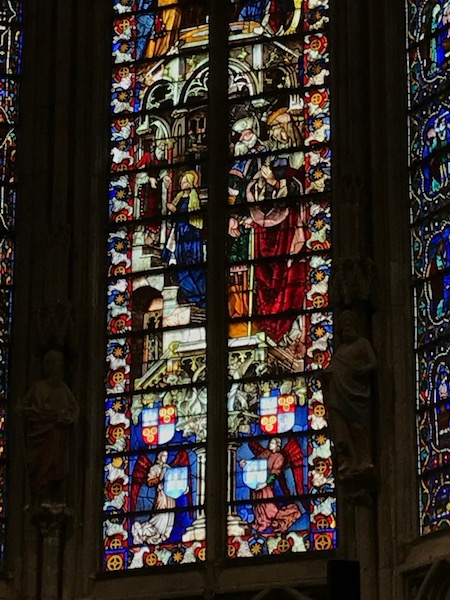

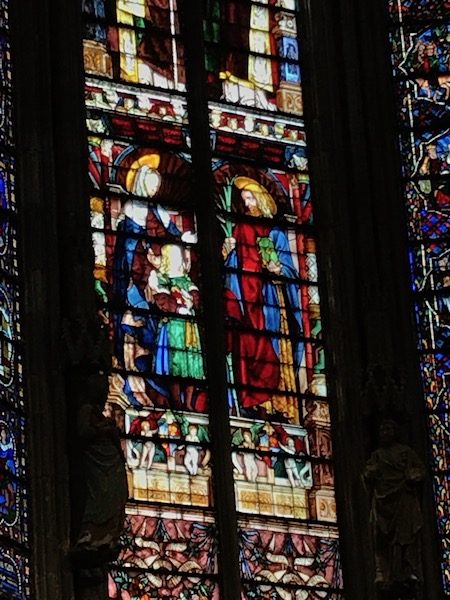
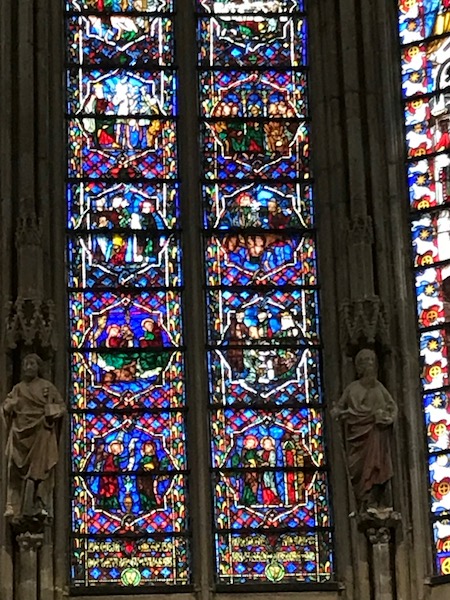
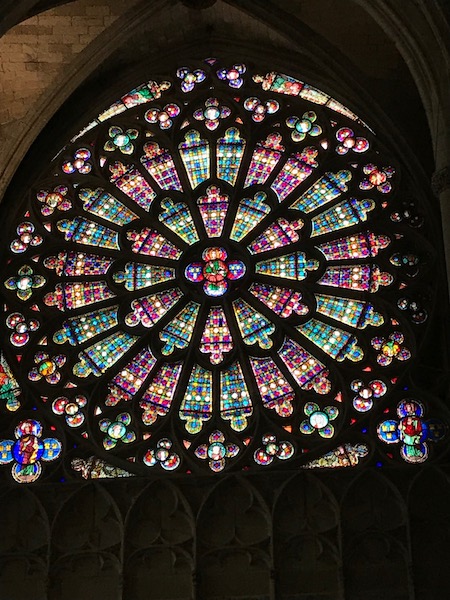
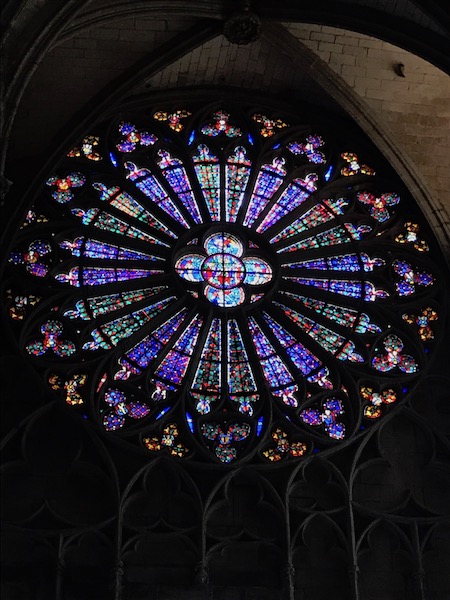
Up against the interior city walls is the Château, which was built in the 12th century by the Trencavel family, who were the Viscounts of Carcassonne. They constantly altered it, in many cases to add more and more fortifications for defense, including a ring of fortifications in the 13th century, including a curtain wall, circular towers, a small castle at the entrance, a barbican and a moat. In the 19th century, the citadel was on the verge of demolition, as it had fallen into disrepair. For 50 years, the various buildings and walls were restored from pictures and information in various archives. The first pictures, you can clearly see what used to be the moat with the bridge to connect the château and the barbican, which was added for protection. The 2nd picture shows Tom (the blue shirt) on the bridge heading to the château. The 3rd picture here is of the barbican itself. Of special note is the gatehouse, which is open on the inside. This was so that if the barbican was taken by the enemy, they couldn't hide from crossbows fired from the castle.
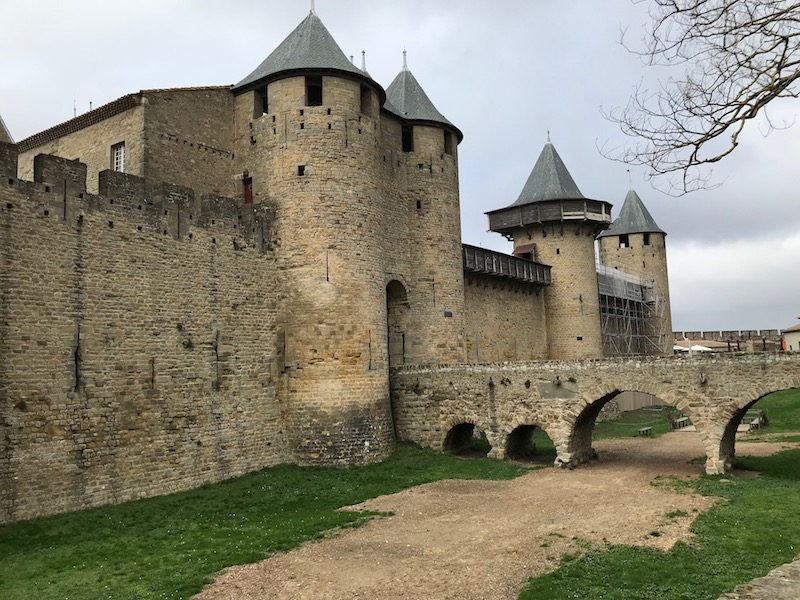


There are 2 main courtyards, which I believe they said was originally a single large courtyard and was split by building a wing of the château in the middle (well, not directly in the middle since one is much larger than the other). The smaller one is called the Midi Courtyard and it is a bit interesting ... one side of this courtyard used to actually be rooms on the 2nd floor with an open walkway beneath. If you look on the left side of the first picture, you may be able to make out a couple indentions about middle-way up and middle-way down the wall ... one of these is actually the remains of a chimney! Then we headed a little bit on the West ramparts to grab a couple pictures of the rooftops and church.


One of the few interesting rooms that was open to us at this time, this has some interesting murals that have been partially recovered. They are paintings from the 12th or early 13th century showing a combat between Christian and Saracen knights.



Court of Honor, which you can pick out various different time periods in the architecture, including the one part where you see the half-timbered house.





There really wasn't that much to actually see in the château since a good bit of it was closed for work, but we did take the opportunity to walk out along the inner ramparts of the city on the South side. We got some great views of the buildings in the citadel and the churches.




Saint Michel Cathedral goes back to the 18th and 19th centuries and also is in the gothic style of the Languedoc region. It became a cathedral in 1803 after the Basilica of Saint Nazaire fell out of use. It was restored by Viollet le Duc (the same person who restored much of the Citadel) following a fire in 1849. The exterior is very "bland" ... It is another single-nave church with side chapels around the edges. Some of the windows date back to the 14th century but had to be restored after the 1849 fire. The interior seems to have been redone also rather recently, as the decor color hadn't really faded, and you can see the very "modern" lights.




